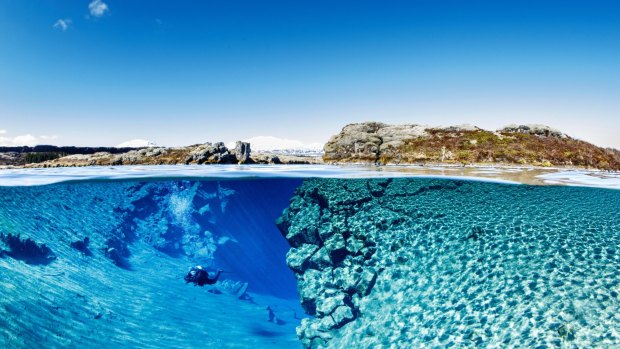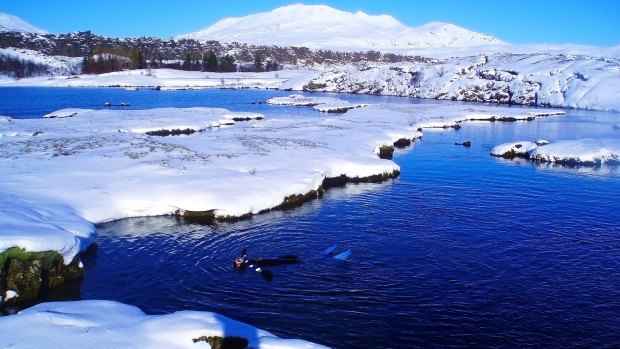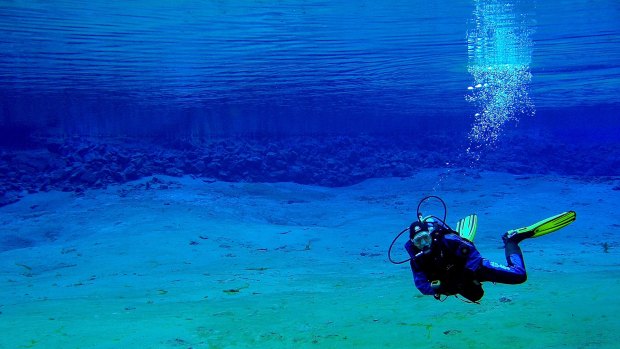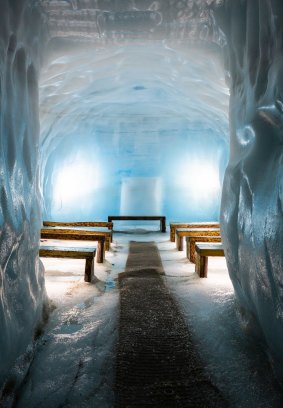This was published 4 years ago
Snorkelling the Silfra fissure, Thingvellir World Heritage Site, Iceland

A diver exits the cathedral at the spectacular Silfra fissure.Credit: Alamy
The last time I went snorkelling, I ended up with sunburn all over my back after spending a little too long face down, gawking at the coral. This will not be happening at Silfra.
If asked to list the world's great snorkelling destinations, the Great Barrier Reef, the Maldives and the Caribbean might well be up there. Iceland, it's fair to say, would not.
Head to the north Atlantic, and you're not going to find any coral. It, quite understandably, doesn't much fancy spending time in water that cold. You're also not going to find Nemo, or shoals of adorably pretty parrotfish. What you will find, however, is the earth's stitches coming apart.

Come on in, the water's fine ... floating on the Silfra fissure.Credit: Dive.is
Iceland is in a pretty much permanent state of geological upset. It is formed on the join of two tectonic plates – the Eurasian and North American. The boundary between the two runs through the middle of the country, and it is massively unstable – hence the country's disposition for volcanic eruptions, geysers and bubbling mud pools.
The plates are moving apart, at a rate of about two centimetres each year. And the Silfra fissure, inside the Thingvellir World Heritage Site, is the gap that has been created as a result.
Preparing to enter the fissure takes a lot of preparation, not because it's especially dangerous, but because it's grimly cold this close to the Arctic Circle.

Snorkelling the Silfra fissure.Credit: Dive.is
The surroundings may be starkly beautiful – the horizon fills with mountaintops and mossy lava fields, while the national flag billows in the wind on the site of Iceland's first ever parliament – but there's little glamour in standing half naked in a car park, trying to don a dry suit.
Dry suits work fundamentally differently to wet suits. The latter are designed to let water in, but keep it warm by pressing against the skin. You really don't want that when the water has come from a glacier, so a dry suit's task is to keep all the water out. Wrestling it on over socks, shirts and thermal leggings is quite the Herculean task. Eventually, the only way of getting my head through the neck hole is walking backwards while snorkelling guide Asgeir wrenches and yanks the suit into place. It's a fairly humiliating experience for someone who has been happily dressing himself for three decades.
"The only bits of the body that should get cold are the bits of your face left exposed," says Asgeir, who has perfected the bushy-bearded Game of Thrones wildling look. "And maybe your hands, if water gets into the gloves. But the less you move your hands, the better."

A small church inside the Langjokull glacier tunnel.Credit: Shutterstock
When – finally – everyone is suited up and looking thoroughly ridiculous, it's a short walk down to the water's edge, where a tiered metal platform has been built to ensure people get in safely.
The expected yelps and screams don't emerge as people take the plunge, however. That's partly because the dry suits do their job, but largely because it is absolutely astonishing down there.
The water may be about 3 degrees, but it has spectacular clarity. It has come down, painstakingly slowly over the course of 30 years, from the Langjokull glacier. On the way, it has encountered little else but basalt rock, which is as effective a filter as nature has ever managed to invent. It's the reason why Iceland's drinking water is so good, and it ensures that visibility in the fissure is top notch, with no soil run-offs, nutrients or sediments to cloud things up.
The crack between the rock walls goes 63 metres down, and I think I can see every one of them through ever-darker bands of blue.
To the sides, those rough-hewn chunks of basalt pile on top of each other in a disorderly, gigantic rubble heap manner. The effect is similar to walking through a narrow gorge – except with the twist of swimming instead. Occasionally the gorge narrows and some passages are a bit of a tight squeeze.
The only signs of life are little hair-like mosses on the rocks, otherwise it's the near-sterile deadness that makes it feel so otherworldly.
Actively moving feels like it would break the spell, and there's no real need to because the current creates a water park lazy river effect, slowly sweeping the bodies out towards the Thingvallavatn lake. Even so, every steering movement of the arm feels like cheating; a concession to the real world, rather than the CGI science-fiction universe I find myself drifting through.
With body essentially numb due to the dry suit, and nary a splash to be heard, virtually all the sensory stimulus is channelled into the vision. It's an incredibly rare experience, and soon the overpowering nature of it takes over from the exciting gimmick of swimming between continents.
Eventually, the trance has to be snapped out of, as we drift away from those mighty basalt walls into the lake. The body has to stir into action again, and swim for the shore. And it's only when we emerge from the water that we realise how red our faces and how puffy our lips are.
Getting out of a dry suit is just as dignified as getting into one, it turns out. The process isn't helped by the mind being elsewhere, in a strange distant daze. What was expected to be a heart-pumping adrenalin rush in icy cold waters has produced an entirely different vibe – eerily soothing and de-stressing.
The Silfra fissure might be caused by the earth's internal turmoil, but while floating through it, all is calm.
FIVE MORE WEIRD ICELANDIC ADVENTURES
GO INSIDE A VOLCANO
The Thrihnukagigur on the Reykjanes Peninsula has a unique, uncollapsed magma chamber, and you can go down inside it on a specially-designed lift. The colours and enormity are jaw-dropping. The tour costs ISK42,000 ($481). See insidethevolcano.com
... OR A GLACIER
After bobbing along the ice in a monster truck, enter a hatch to find a network of tunnels carved into the Langjokull glacier. The sights, including a room used as a chapel, are complemented by the gurgling sounds of the shifting ice. From ISK19,500 ($224) See intotheglacier.is
... OR A LAVA TUNNEL
Vidgelmere is no ordinary cave – it's the result of a volcano eruption, where the lava flow cut out a 1.6-kilometre-long tunnel. Tours cost ISK6500 ($75). See thecave.is
CRUISE THE ICEBERG LAKE
Jokulsarlon is a milky light blue lake, formed by the retreating Breioamerkurjokull glacier. Boat cruises head out to ogle the ever-changing the icebergs before sidling up close to the glacier wall. From ISK5700 ($66) See icelagoon.is
GO WHALE AND PUFFIN-WATCHING
From Husavik, North Sailing heads out on a traditional sailing ship to see minke and humpback whales – hopefully passing dolphins and puffins on the way. From ISK12,500 ($144) See northsailing.is
A Finnair/ Cathay Pacific codeshare, via Hong Kong and Helsinki, is the most efficient route to Iceland from Melbourne and Sydney. It's still 28 hours, and around $1650, though. See Finnair.com
TOUR
British-based Iceland specialist Discover the World offers seven-night self-drive holidays, including car rental with pre-loaded guide iPads and ensuite, private accommodation, from £790 ($1422) a person. Tailor-made itineraries can be designed to include the snorkelling trip and other activities. See discover-the-world.com
The Silfra fissure is around an hour's drive from Reykjavik, and Dive.is runs snorkelling tours there for from ISK14,490 ($166).
David Whitley was a guest of Discover The World. See discover-the-world.com
Sign up for the Traveller Deals newsletter
Get exclusive travel deals delivered straight to your inbox. Sign up now.